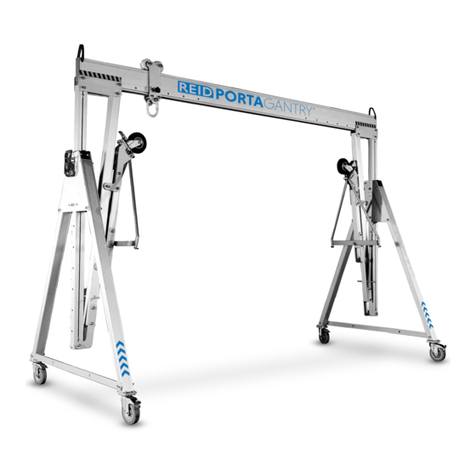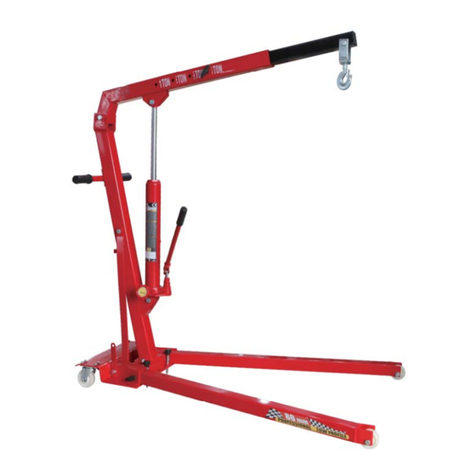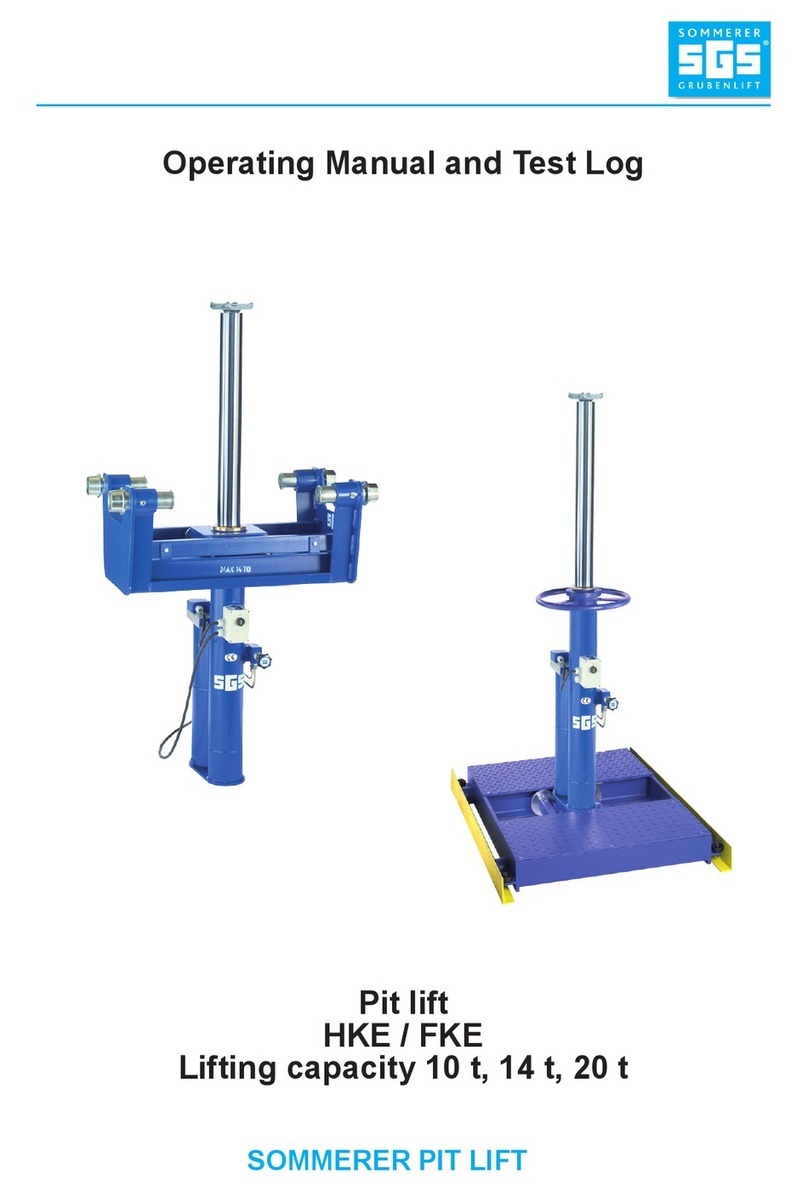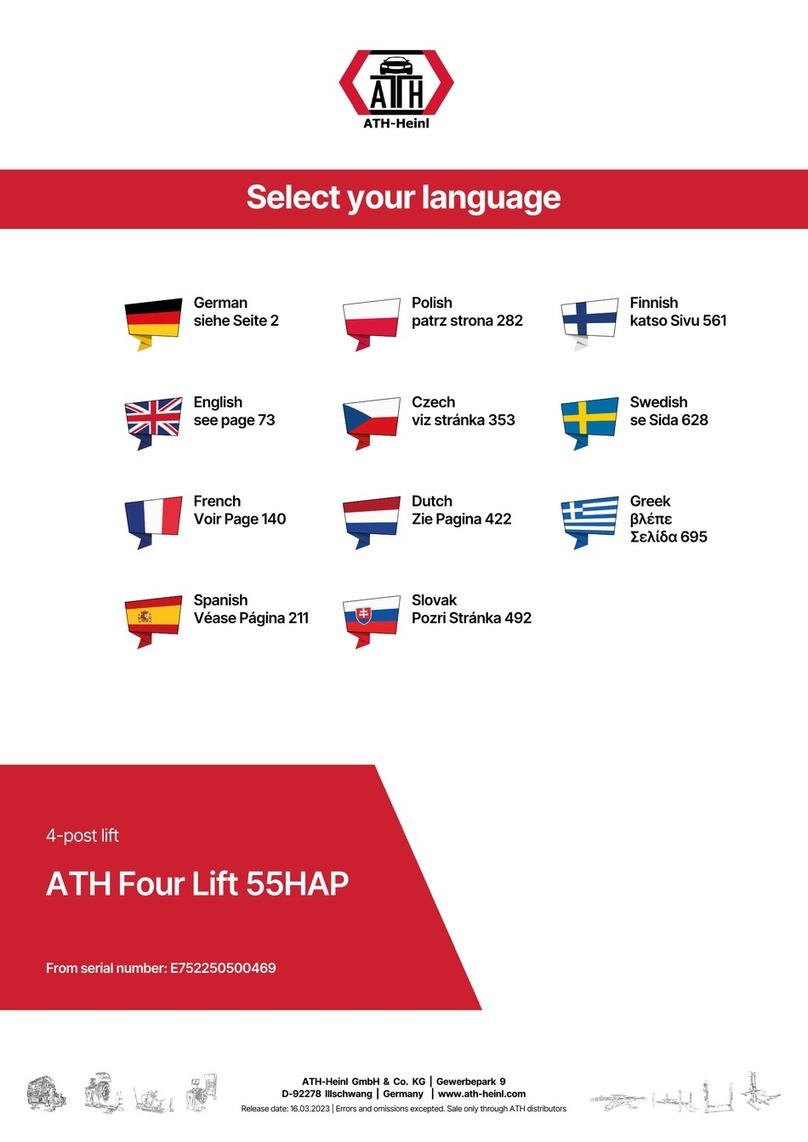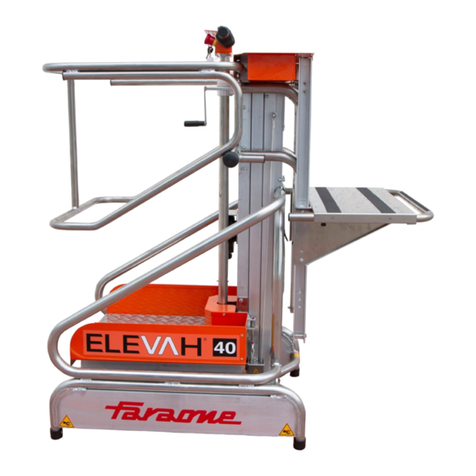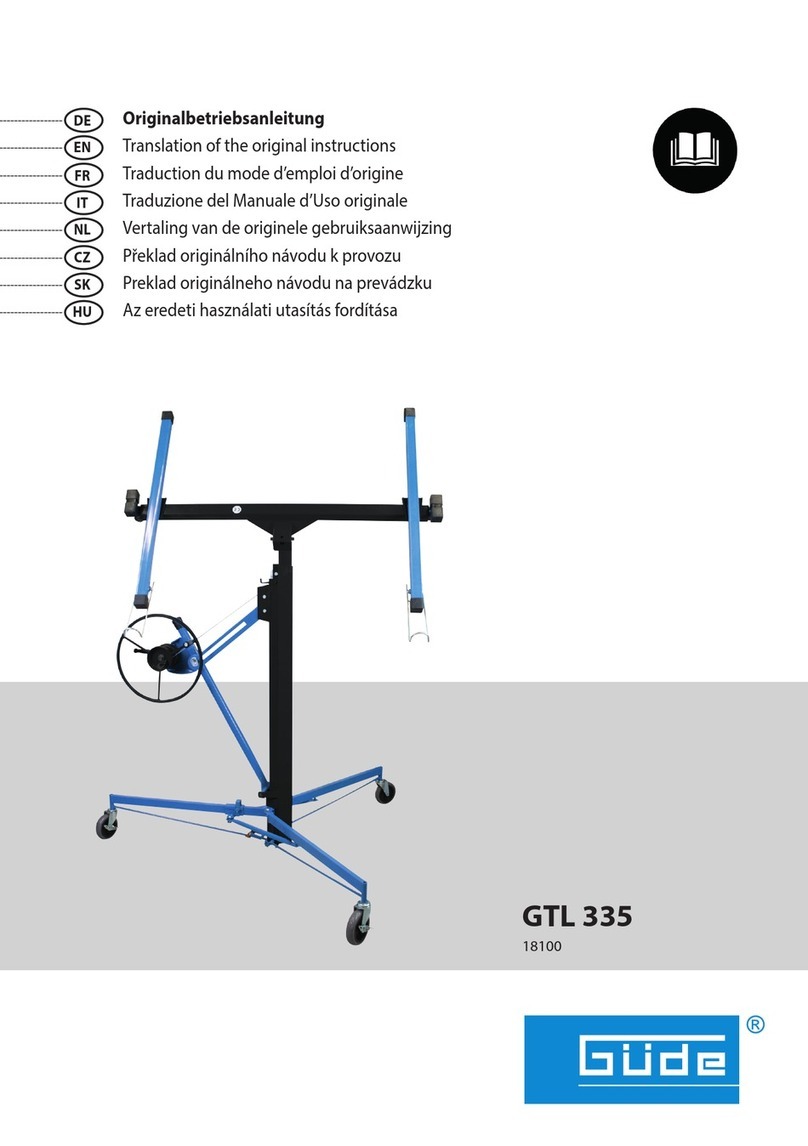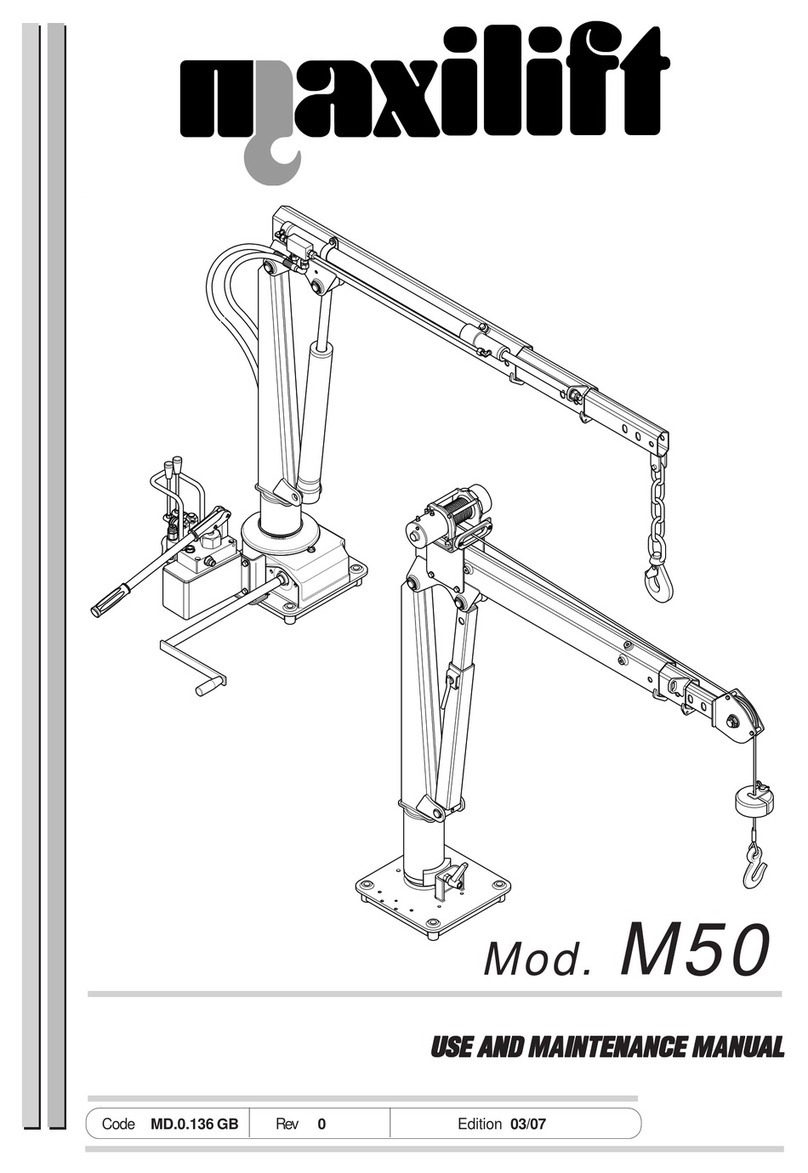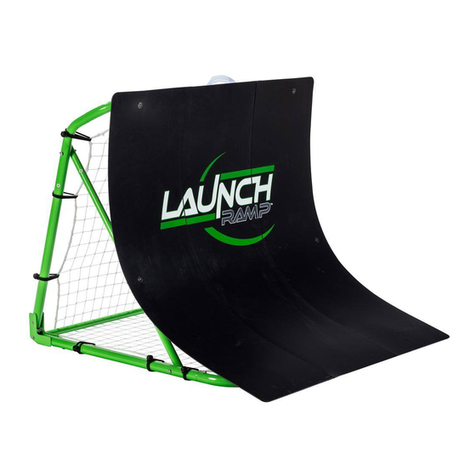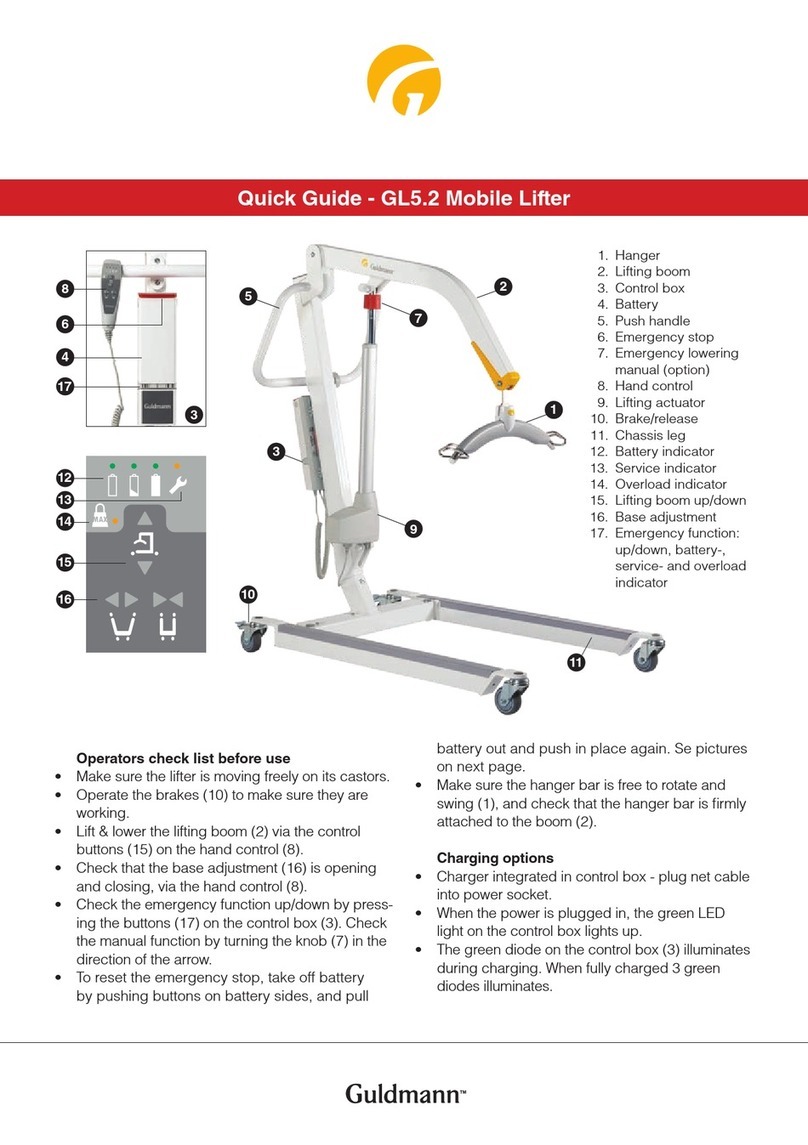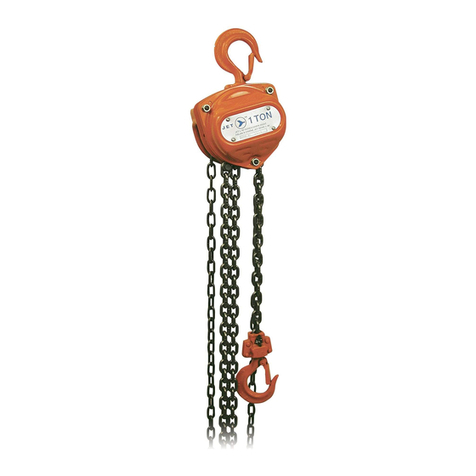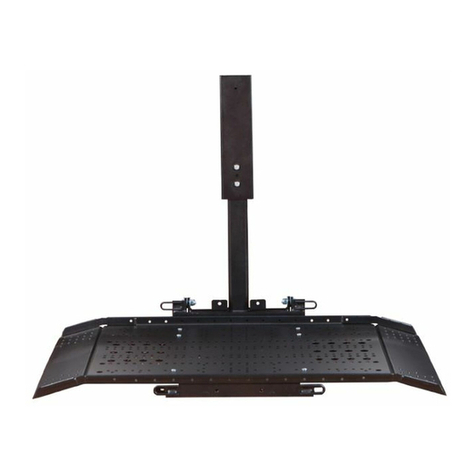SIVIK STD-7330 User manual

REV. 02 1 / 30
USE
AND
MAINTENANCE
MANUAL
DOUBLE SCISSOR LIFT
FLUSH MOUNTED
STD-7330

REV. 02 2 / 30
PRINTING CHARACTERS AND SYMBOLS
Throughout this manual, the following symbols and printing characters are used to facilitate reading:
Indicates the operations which need proper care
Indicates prohibition
Indicates a possibility of danger for the operators
ÕIndicates the direction of access for motor vehicles to the lift
BOLD
TYPE Important information
WARNING: before operating the lift and carrying out any adjustment, read
carefully chapter 7 “installation” where all proper operations for a better
functioning of the lift are shown.

REV. 02 3 / 30
CONTENTS
1 GENERAL INFORMATION 4
2 PRODUCT IDENTIFICATION 6
3 PACKING, TRANSPORT AND STORAGE 7
4 PRODUCT DESCRIPTION 8
5 TECHNICAL SPECIFICATION 9
6 SAFETY 16
7 INSTALLATION 19
8 OPERATION AND USE 26
9 MAINTENANCE 29
10 TROUBLESHOOTING 30

REV. 02 4 / 30
CHAPTER 1 – GENERAL INFORMATION
This chapter contains warning instructions to operate the lift properly and prevent injury to operators
or objects.
This manual has been written to be used by shop technicians in charge of the lift (operator) and routine
maintenance technician (maintenance operator).
The operating instructions are considered to be an integral part of the machine and must remain with it
for its whole useful life.
Read every section of this manual carefully before operating the lift and unpacking it since it gives
helpful information about:
- SAFETY OF PEOPLE
-SAFETY OF THE LIFT
-SAFETY OF LIFTED VEHICLES
The company is not liable for possible problems, damage, accidents, etc. resulting from failure to
follow the instructions contained in this manual.
Only skilled technicians of AUTHORISED DEALERS or SERVICE CENTRES AUTHORISED by
the manufacturer shall be allowed to carry out lifting, transport, assembling, installation, adjustment,
calibration, settings, extraordinary maintenance, repairs, overhauling and dismantling of the lift.
THE MANUFACTURER IS NOT RESPONSIBLE FOR POSSIBLE DAMAGE TO PEOPLE,VEHICLES OR
OBJECTS IF SAID OPERATIONS ARE CARRIED OUT BY UNAUTHORIZED PERSONNEL OR THE LIFT IS
IMPROPERLY USED.
Any use of the machine made by operators who are not familiar with the instructions and procedures
contained herein shall be forbidden.
1.1 MANUAL KEEPING
For a proper use of this manual, the following is recommended:
•keep the manual near the lift, in an easily accessible place.
•keep the manual in an area protected from the damp.
•use this manual properly without damaging it.
•Any use of the machine made by operators who are not familiar with the instructions and
procedures contained herein shall be forbidden.
This manual is an integral part of the lift: it shall be given to the new owner if and when the lift is
resold.
1.2 OBLIGATION IN CASE OF MALFUNCTION
In case of machine malfunction, follow the instructions contained in the following
chapters.

REV. 02 5 / 30
1.3 CAUTIONS FOR THE SAFETY OF THE OPERATOR
Operators must not be under the influence of sedatives, drugs or alcohol when operating the machine.
Before operating the lift, operators must be familiar with the position and function
of all controls, as well as with the machine features shown in the chapter
“Operation and use”
1.4 WARNINGS
Unauthorized changes and/or modifications to the machine relieve the
manufacturer of any liability for possible damages to objects or people. Do not
remove or make inoperative the safety devices, this would cause a violation of safety
at work laws and regulations.
Any other use which differs from that provided for by the manufacturer of the
machine is strictly forbidden.
The use of non genuine parts may cause damage to people or objects
DECLARATION OF WARRANTY AND LIMITATION OF LIABILITY
The manufacturer has paid proper attention to the preparation of this manual. However, nothing
contained herein modifies or alters, in any way, the terms and conditions of manufacturer agreement
by which this lift was acquired, nor increase, in any way, manufacturer’s liability to the customer.
TO THE READER
Every effort has been made to ensure that the information contained in this manual is correct, complete
and up-to date. The manufacturer is not liable for any mistakes made when drawing up this manual
and reserves the right to make any changes due the development of the product, at any time.

REV. 02 6 / 30
CHAPTER 2 – PRODUCT IDENTIFICATION
The identification data of the machine are shown in the label placed on the control unit.
Use the above data both to order spare parts and when getting in touch with the
manufacturer (inquiry). The removal of this label is strictly forbidden.
Machines may be updated or slightly modified from an aesthetic point of view and, as a consequence,
they may present different features from these shown, this without prejudicing what has been
described herein.
2.1 WARRANTY CERTIFICATE
The warranty is valid for a period of 12 months starting from the date of the purchase invoice.
The warranty will come immediately to an end when unauthorized modifications to the machine or
parts of it are carried out.
The presence of defects in workmanship must be verified by the Manufacturer’s personnel in charge.
2.2 TECHNICAL SERVICING
For all servicing and maintenance operations not specified or shown in these instructions, contact
your Dealer where the machine has been bought or the Manufacturer’s Commercial Department.
Only skilled personnel who are familiar with the lift and this manual shall be allowed to carry out
packing, lifting, handling, transport and unpacking operations.
LOGO
Type: ……….
Model: ……….
Serial Number: ……….
Year of manufacturing: ……….
Capacity: ……….
Voltage: ……….
Power: ……….

REV. 02 7 / 30
CHAPTER 3 - PACKING, TRANSPORT AND STORAGE
3.1 PACKING
The packing of the lift is delivered in following components:
¾N. 2 base units each packed in a steel frame, wrapped up in non-scratch material
¾N. 1 power unit packed in a plywood box, including N. 8 rubber pads and N. 8 anchor bolts
(If requested, optional accessories are available to satisfy each customer’s requirements).
The average weight of the package is 800kg.
3.2 LIFTING AND HANDLING
When loading/unloading or transporting the equipment to the site, be sure to use suitable loading (e.g.
cranes, trucks) and hoisting means. Be sure also to hoist and transport the components securely so that
they cannot drop, taking into consideration the package’s size, weight and centre of gravity and it’s
fragile parts.
Hoist and handle only one package at a time
3.3 STORAGE AND STACKING OF PACKAGES
Packages must be stored in a covered place, out of direct sunlight and in low humidity, at a
temperature between -10°C and +40°C.
Stacking is not recommended: the package’s narrow base, as well as its considerable weight and size
make it difficult and hazardous.
3.4 DELIVERY AND CHECK OF PACKAGES
When the lift is delivered, check for possible damages due to transport and storage; verify that what
is specified in the manufacturer’s confirmation of order is included. In case of damage in transit, the
customer must immediately inform the carrier of the problem.
Packages must be opened paying attention not to cause damage to people (keep a safe distance when
opening straps) and parts of the lift (be careful the objects do not drop from the package when
opening).

REV. 02 8 / 30
CHAPTER 4 - PRODUCT DESCRIPTION
4.1 LIFT DESCRIPTION (Ref. Figure 1)
The flush mounted lift has been designed for the lifting of motor-vehicles for wheel alignment and
maintenance.
The maximum lifting weight is as specified on the serial plate.
All mechanical frames, such as platforms, extensions, base frames and arms have been built in steel
plate to make the frame stiff and strong while keeping a low weight
The electro hydraulic operation is described in detail in chapter 8.
This chapter describes the lift’s principal elements, allowing the user to be familiar with the machine.
As shown in figure 1, the lift is composed of two platforms (1) each equipped with a telescopic
extension (2), anchored to the ground by means of two base frames (3).
Platforms are linked to the base frame by means of a scissors lifting system.
The lifting system of each platform is composed of N.4 arms, two inferior (4) and two superior (5),
and a cylinder (6).
Lifting and lowering motion of the lift is controlled by the push buttons on the control panel (7) placed
next to the lift.
The mechanical safety operating by a pneumatic cylinder (8) is installed under each runway.
Two limit switches are installed in the power unit, one for the safety height and the other one for the
maximum lifting height.
Whenever the lift is to be lowered to the ground, the lift will stop at about 400 mm from the ground at
first, then press the final lowering button to lower the lift completely. A beep sound is heard during the
final travel.
Figure 1 – LIFT
1
2
3
5
4
6
7
8

REV. 02 9 / 30
CHAPTER 5 - TECHNICAL SPECIFICATION
5.1 SIZE AND MAIN FEATURES (Ref. Figure 2)
CAPACITY 3000KG
Max. lifting height 2060mm
Length of the platform 1540 - 1740 mm
Width of platform 550mm
Free width between platforms 800mm
Overall length 1540mm
Overall width 1900mm
Lifting time 60 s
Lowering time 60 s
Compressed air pressure 6 bar – 8 bar
Noise level 80 dB(A)/1m
Working temperature -10 °C
÷
40 °C
Average weight of package 800g
5.2 ELECTRIC MOTOR
Type ML90L2 G90N4
Voltage 230V/220V-1Ph 400V/380V-3Ph
Power 2.2 KW 2.6 KW
N° Poles 2 4
Speed 2800 rpm 1375 rpm
Motor enclosure type B14
Insulation class IP 54
Motor connection must be carried out referring to the attached wiring diagrams (the figure 5).
The motor direction of rotation is shown in the label placed on the motor.
Before use of the lift, make sure to check if the motor specification shown in the nameplate of
the motor conforms to the local electric supply.
If there is over 10% fluctuation on the electrical power supply,it is suggested to use the voltage
stabilizer to protect the electrical components and system from overloading.
5.3 PUMP
Type Gear
Flow rate 2.0 cm
3
/g 4.8 cm
3
/g
Continuous working pressure 210 bar – 230 bar
Peak pressure 250 bar

REV. 02 10 / 30
Figure 2 - LAYOUT
Drive on

REV. 02 11 / 30
5.4 HYDRUALIC POWER UNIT
FIG. 3 – HYDRAULIC POWER UNIT
5.5 OIL
Use wear proof oil for hydraulic drive, in conformity with ISO 6743/4 rules (HM class). The oil with
features similar to those shown in the table is recommended.
TEST STANDARDS FEATURES VALUE
ASTM D 1298 Density 20°C 0.8 kg/l
ASTM D 445 Viscosity 40°C 32 cSt
ASTM D 445 Viscosity 100°C 5.43 cSt
ASTM D 2270 Viscosity index 104 N°
ASTM D 97 Pour point ∼30 °C
ASTM D 92 Flash point 215 °C
ASTM D 644 Neutralization number 0.5 mg KOH/g
CHANGE HYDRAULIC OIL AT 1YEAR INTERVALS
Motor
Leveling cutoff cock
N.O (normally open)
Oil tank
Emergency
han
d
p
ump
Lowering
solenoid valve
Emergency
lowering screw
Pressre gauge
Leveling cutoff cock
N.C (normally close)
Maximum pressure valve

REV. 02 12 / 30
Figure 4 – HYDRAULIC PLAN
1 Master hydraulic cylinder 8 Lowering solenoid valve
2 Slave hydraulic cylinder 9 Lowering control valve
3 Leveling cutoff cock (normally open) 10 Motor
4 Leveling cutoff cock (normally close) 11 Gear pump
5 Pressure gauge 12 Emergency hand
p
ump
6 Non return valve 13 Oil filter
7 Maximum pressure valve 14 Parachute valve

REV. 02 13 / 30
Figure 5a – ELECTRIC DIAGRAM (380V/400V-3PH)
QF Power switch SB1 Liftin
g
b
utton
M Motor 2.6KW 3PH SB2 Lowering
b
utton
ST Overhead protector SB3 Final lowering
b
utton
T Transformer 63VA JD Beeper
K
M
Contactor DC SQ1 Max. lifting height limit switch
Y
V
Lowering solenoid valve SQ2 Safet
y
height limit switch
Q
V
Solenoid air
v
alve
Dispaly

REV. 02 14 / 30
Figure 5b – ELECTRIC DIAGRAM (220V/230V-1PH)
QF Power switch SB1 Liftin
g
b
utton
M Motor 2.2KW 1PH SB2 Lowering
b
utton
ST Overhead protector SB3 Final lowering
b
utton
T Transformer 63VA JD Beeper
K
M
Contactor DC SQ1 Max. lifting height limit switch
Y
V
Lowering solenoid valve SQ2 Safet
y
height limit switch
Q
V
Solenoid air
v
alve
Display
N2
N1
1
L2
F1
L1
F2

REV. 02 15 / 30
Figure. 6 – PNEUMATIC PLAN
Pneumatic cylinders
Solenoid air valve
Water separator and
lubricator
Compressed air supply

REV. 02 16 / 30
CHAPTER 6 – SAFETY
Read this chapter carefully and completely because it contains important information for the safety
of the operator and the person in charge of maintenance.
The lift has been designed and built for lifting vehicles and making them stand
above level in a closed area. any other use is forbidden, including the following
operations:
The manufacturer is not liable for possible damages to people, vehicles or objects
resulting from an improper or unauthorized use of the lift.
For operator and people safety, a safety area at least 1m free away from the lift must be vacated
during lifting and lowering. The lift must be operated only from the operator’s control site in this
safety area.
Operator’s presence under the vehicle, during working, is only admitted when the vehicle is lifted
and platforms are not running.
Never use the lift when safety devices are off-line. People, the lift and the vehicles
lifted can be seriously damaged if these instructions are not followed.
6.1 GENERAL WARNINGS
The operator and the person in charge of maintenance must follow accident-prevention laws and
rules in force in the country where the lift is installed
They also must carry out the following:
•neither remove nor disconnect hydraulic, electric or other safety devices;
•carefully follow the safety indications applied on the machine and included in the manual;
•observe the safety area during lifting;
•be sure the motor of the vehicle is off, the gear engaged and the parking brake put on;
•be sure only authorized vehicles are lifted without exceeding the maximum lifting capacity;
•Verify that no one is on the platforms during lifting or standing.
6.2 RISKS DURING VEHICLE LIFTING
To avoid overloading and possible breaking, the following safety devices have been used:
•a maximum pressure valve placed inside the hydraulic unit to prevent excessive weight.
•a special design of the hydraulic system, in case of pipeline failure, to prevent sudden lift
lowering..
The maximum pressure valve has been preset by the manufacturer to a proper
pressure. DO NOT try to adjust it to overrun the rated lifting capacity.
6.3 RISKS FOR PEOPLE
All risks the personnel could run, due to an improper use of the lift, are described in this section.

REV. 02 17 / 30
6.4 PERSONNEL CRUSHING RISKS
During lowering of runways and vehicles, personnel must not be within the area covered by the
lowering trajectory. The operator must be sure no one is in danger before operating the lift.
Fig. 7a Fig. 7b Fig. 7c
6.5 BUMPING RISK
When the lift is stopped at relatively low height for
working, the risk of bumping against projecting parts
occurs.
Fig. 8
6.6 RISK OF THE VEHICLE FALLING FROM THE LIFT
Vehicle falling from the lift can be caused when the vehicle is improperly placed on platforms, and
when its dimensions are incompatible with the lift or by excessive movement of the vehicle.
In this case, keep immediately away from the working area.
Fig. 9a Fig. 9b Fig. 9c
6.7 SLIPPING RISKS
The risk of slipping can be caused by oil or dirt on the floor near
the lift.
Fig. 10
Keep the area under and around the lift clean. Remove all oil spills.
6.8 ELECTROCUTION RISKS
Avoid use of water, steam, and solvent, varnish jets in the lift area where electric cables are placed
and, in particular, next to the electric panel.

REV. 02 18 / 30
6.9 RISKS RESULTING FROM IMPROPER LIGHTING
Make sure all areas next to the lift are well and uniformly lit, according to local regulations.
6.10 RISKS OF BREAKING COMPONENT DURING OPERATION
Materials and procedures, suitable for the designed parameters of the
lift, have been used by the manufacturer to build a safe and reliable
product. Operate the lift only for the use it has been designed for and
follow the maintenance schedule shown in the chapter “Maintenance”. Fig. 11
6.11 RISKS FOR UNAUTHORIZED USES
The presence of unauthorized persons next to the lift and on the
platforms is strictly forbidden during lifting as well as when the vehicle
has been already lifted
Fig. 12
Any use of the lift other than that herein specified can cause serious accidents to
people in close proximity of the machine.

REV. 02 19 / 30
CHAPTER 7 – INSTALLATION
Only skilled technicians, appointed by the manufacturer, or by authorized
dealers, must be allowed to carry out installation. Serious damage to people and
to the lift can be caused if installations are made by unskilled personnel.
7.1 CHECKING FOR ROOM SUITABILITY
The lift has been designed to be used in covered and sheltered places free of overhead obstructions.
The place of installation must not be next to washing areas, painting workbenches, solvent or
varnish deposits. The installation near to rooms, where a dangerous situation of explosion can occur,
is strictly forbidden. The relevant standards of the local Health and Safety at Work regulations, for
instance, with respect to minimum distance to wall or other equipment, escapes and the like, must be
observed.
7.2 LIGHTING
Lighting must be carried out according to the effective regulations of the place of installation. All
areas next to the lift must be well and uniformly lit.
7.3 FOUNDATION
The lift must be placed sufficiently in the concrete pit prepared as shown in the figure 13. The floor
must be suitable for bearing maximum stress values, also in unfavorable working conditions. The
level difference between two pits MUST be less than 3mm, and the height difference within full
length of base frame MUST be less than 5mm. The new concrete must be adequately cured by at
least 20 days minimum.
A level foundation is suggested for proper installation. Small differences may
be compensated for by proper shimming. Any major slope change will affect
the level lifting performance. If the foundation is of questionable slope,
considering to pour the new one.
7.4 LIFT POSITIONING
Unauthorized persons are not allowed to enter during assembly.
•Locate the lift position in the pit according to the drive-on direction of the lift and referring to
the foundation layout (figure. 13). Be sure the side of each platform with the labels towar
d
outside.
•Transport each runway into the pit using hoisting means with load capacity of 500kg at least.
To prevent the platform from dropping during transport, it should be lifted according to its
centre of gravity.
•Place the control unit in the position provided for. The location of control unit can be
positioned in either left or right to meet the customer’s preference.

REV. 02 20 / 30
Figure 13 – PIT FOUNDATION PLAN
Min.1200mm
Max.1500mm
Min.400mm
1580mm
Drive up
≥2000mm
To control unit
770mm
580mm
Min.1600mm
580mm
330mm
100
1580mm
Pipe (inner dia.100)
Concrete(Minimum thickness150mm)
Groove 100X100mm
Pipe (inner dia.100)
placed here
100
Specifications of the pit must be adhered to. Failure to do so could cause lift
failure resulting in personal injury or death.
7.5 HYDRAULIC SYSTEM CONNECTION
•Raise platforms at the half way with auxiliary equipment by using strong ropes, bands or
chains.
•Open the front cover of the control unit.
•Referring to the figure 14 route hydraulic lines through the hole in the prepared pit.
•Connect hydraulic hoses to the fittings referring to the letters shown on them.
•Tighten thoroughly.
When routing the hydraulic hoses in the pit, make sure that the hose is clear of
any moving part, make sure to keep the hoses and fittings clean from dust.
Failure to do so may result in hydraulic line failure which may result in
damage or personal harm.
Table of contents



